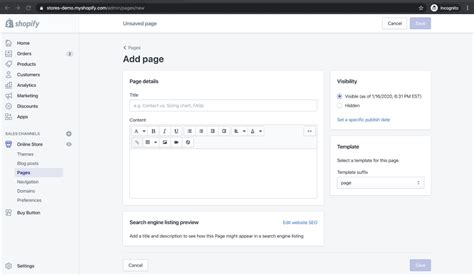Shopify has revolutionized the world of e-commerce, making it easier for businesses to create and manage their online stores. One of the key features that contribute to Shopify's success is its default page template. In this article, we'll delve into the world of Shopify's default page template, exploring its benefits, components, and customization options.
The Importance of a Well-Designed Page Template
A well-designed page template is crucial for any e-commerce website, as it sets the tone for the overall user experience. A good template can make or break a website's success, as it affects how customers interact with the site, navigate through pages, and ultimately make purchases. Shopify's default page template provides a solid foundation for businesses to build upon, ensuring a seamless and user-friendly experience for customers.
Understanding Shopify's Default Page Template
Shopify's default page template is a pre-designed layout that comes with every new Shopify store. This template includes all the essential elements of an e-commerce website, such as a header, footer, navigation menu, product listings, and more. The default template is designed to be responsive, meaning it adapts to different screen sizes and devices, ensuring a consistent user experience across various platforms.

Components of Shopify's Default Page Template
Shopify's default page template consists of several key components, including:
- Header: The top section of the page that typically includes the store's logo, navigation menu, and search bar.
- Navigation Menu: A dropdown menu that allows customers to browse through different categories and pages.
- Product Listings: A grid or list view of products, including images, prices, and descriptions.
- Footer: The bottom section of the page that typically includes contact information, social media links, and other secondary content.
- Sidebar: A column that can be used to display additional content, such as promotions, blog posts, or product recommendations.
Customizing Shopify's Default Page Template
While Shopify's default page template provides a solid foundation, businesses may want to customize it to reflect their brand's unique identity and style. Fortunately, Shopify offers a range of customization options, including:
- Theme Editor: A visual editor that allows businesses to modify the layout, colors, and fonts of their store.
- Liquid Code: A templating language that allows developers to customize the store's layout and functionality.
- Apps: Third-party apps that can be integrated into the store to add new features and functionality.
Benefits of Customizing Shopify's Default Page Template
Customizing Shopify's default page template can have several benefits, including:
- Improved Branding: A customized template can help businesses establish a strong brand identity and differentiate themselves from competitors.
- Enhanced User Experience: A well-designed template can improve navigation, make it easier for customers to find what they're looking for, and increase conversions.
- Increased Conversions: A customized template can help businesses optimize their store's layout and design to increase sales and revenue.
Tips for Customizing Shopify's Default Page Template
When customizing Shopify's default page template, businesses should keep the following tips in mind:
- Keep it Simple: Avoid cluttering the page with too much content or complex layouts.
- Use High-Quality Images: Use high-quality images that are optimized for web use to improve the store's visual appeal.
- Test and Iterate: Test different layouts and designs, and iterate based on customer feedback and performance data.
Common Mistakes to Avoid When Customizing Shopify's Default Page Template
When customizing Shopify's default page template, businesses should avoid the following common mistakes:
- Over-Customization: Avoid making too many changes, as this can result in a template that looks and feels unfamiliar to customers.
- Poor Mobile Optimization: Ensure that the template is optimized for mobile devices, as this can affect the user experience and conversions.
- Inconsistent Branding: Ensure that the template aligns with the business's overall brand identity and style.
Conclusion
Shopify's default page template provides a solid foundation for businesses to build upon. By understanding the components of the template and customizing it to reflect their brand's unique identity and style, businesses can improve the user experience, increase conversions, and establish a strong online presence.

Getting Started with Shopify's Default Page Template
If you're new to Shopify, getting started with the default page template is easy. Simply sign up for a Shopify account, choose a theme, and start customizing your store. If you're already using Shopify, you can access the theme editor by going to the "Online Store" section of your dashboard and clicking on "Themes."
What's Next?
We hope this guide has provided you with a comprehensive understanding of Shopify's default page template and how to customize it to suit your business needs. If you have any questions or need further assistance, please don't hesitate to reach out.
Share Your Thoughts
We'd love to hear about your experiences with Shopify's default page template. Share your thoughts, tips, and feedback in the comments section below.
What is Shopify's default page template?
+Shopify's default page template is a pre-designed layout that comes with every new Shopify store. It includes all the essential elements of an e-commerce website, such as a header, footer, navigation menu, product listings, and more.
How do I customize Shopify's default page template?
+Shopify offers a range of customization options, including the theme editor, liquid code, and third-party apps. You can access the theme editor by going to the "Online Store" section of your dashboard and clicking on "Themes."
What are the benefits of customizing Shopify's default page template?
+Customizing Shopify's default page template can improve the user experience, increase conversions, and establish a strong brand identity. It can also help businesses differentiate themselves from competitors and increase sales and revenue.
